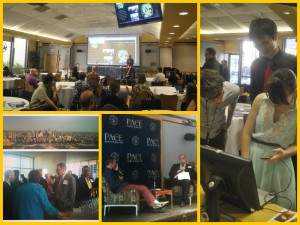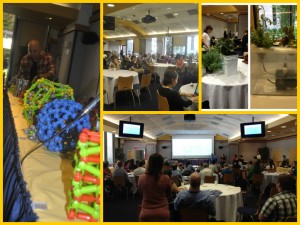We just had an eventful and exciting weekend here at Seidenberg! The much anticipated two-day STEM conference has now come and gone, but in its wake remains many new things to discuss, mobile apps to use, plants to tend to, and ZOOBs to play with.

The two-day event consisted of a VIP luncheon, an evening mixer, and a collaboratory conference. The main topics discussed included technology’s role in educational settings, the importance of approaching technology critically, and how computing should be interdisciplinary but also stand as a full, separate subject.
Our keynote speaker was PhD Media Theorist, Author, and Codecademy’s Evangelist, Douglas Rushkoff. Well-spoken, energetic, and clearly passionate about the day’s topic, Rushkoff had a lot to say about the relationship between technology and education from its past to its trajectory. A main point in his discussion was how programming should be approached as literacy. Students should be as well-rounded in computing as they are expected to be in other subjects. As he mentions in his book Program or Be Programmed, it is not okay to be a mere passenger in the technological world; students should be focused on learning less about basic skills in user-oriented program packages, such as Microsoft Office, and more about the programming skills that give us those packages in the first place. Rushkoff stated that he prefers to approach computing as a liberal art and a science–a type of engineering that he likened to cooking. Cooking is hugely scientific. The chemistry of the elements and how they blend is essential to the task yet cooking can be creative and artful and requires the capacity to multitask as well.
Rushkoff is also a big advocate for experiential education, as described by a mantra, “see one, do one, teach one,” which is part of Codecademy’s teaching process.
When Rushkoff asked the audience for feedback, many of the teachers in the crowd (not all of whom come from a computing or STEM subject) agreed with his stance on the matter. The questions that arose were those of what to do next. One teacher asked how to find a suitable entry point when teaching computing, to which Rushkoff responded that questioning, comparison, and critique are the first steps of learning. To begin, students must approach programming as a liberal art, then they may delve deeper into technical learning.
With that much said, Rushkoff bid the conference farewell and Michael Joaquin Grey, an artist and inventor, stepped up to show everyone his invention: ZOOBs. Disguised as a toy for kids, like Legos or Tinkertoys, ZOOBs are building blocks for all kinds of structures. The unique thing about them is that they are modeled after anatomical and naturally occurring joints and connectors, so the structures that form are mobile and can be close to actual anatomies. Grey presented to the audience a model of a DNA helix that was flexible. From that model, one could see how the DNA can wrap up into different shapes, as it does in living cells. There are five different pieces, which are five different colors, just as there are five vowels, five fingers, five base pairs, five joints. ‘ZOOB’ itself is an acronym for Zoology, Ontology, Ontogeny, and Botany. Grey is now working on projects related to sensory integration issues and computational cinema.
After everyone got their share of playtime with the all-too-addictive ZOOBs, students, professors, and teachers who have been working on their own mobile apps presented their respective programs to the rest of the group. Each app was one geared towards educating and could eventually be used in a classroom setting. The apps, created from scratch, ranged from chemistry rummy to an app for measurements in biology to an app that hosts a virtual patient.
To open back up to the topic of the day, there was a panel discussion that continued off of Douglas Rushkoff’s conversation. The panel featured Steve Ettlinger, author of Twinkie, Deconstructed, Brian Evans and Tom Lynch, both of whom are professors in the School of Education here at Pace, Lou Lahana, a teacher at The Island School, and PhD Meghan Groome, the Executive Director of Education & Public Programs at New York Academy of Science. The moderator was Ben Esner, Director of K-12 STEM Education at Polytechnic Institute at New York University. The discussion flowed through the vision for STEM Education, to techniques and examples in curricula, to publicizing it all to generate a larger discussion across the globe. Audience members were also able to add their two-cents when the time came. One teacher in particular expressed her views that teachers in Pace as well as teachers in any other institute should be able to access curated advice on technology, since no one will have to time to keep up with technology as new devices appear while obtaining the necessary skill levels to teach with each new device. Instead, this teacher hoped that a forum would open up either online or in the form of an association that will produce reputable advice on which technologies are the best in a classroom environment and when it is necessary to update.


